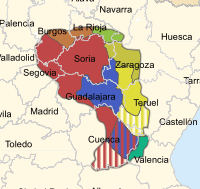Lusones

The Lusones (Greek: Lousones) were an ancient Celtiberian (Pre-Roman) people of the Iberian Peninsula (the Roman Hispania), who lived in the high Tajuña River valley, northeast of Guadalajara.[1] They were eliminated by the Romans as a significant threat in the end of the 2nd century BC.
Origins
They spoke a variety of the Celtiberian language and were a subdivision of the Celtiberians.[2] There is an overwhelming amount of evidence that the ancestors of the Celtiberian groups were installed in the Meseta area of the Iberian Peninsula from at least 1000 BC and probably much earlier.[3]
Location
The Lusones' lands were located in the Aragonese region along the middle Ebro, on the Moncayo range (Latin: Mons Chaunus) between the Queiles and Huecha rivers, occupying the western Zaragoza and most of Soria, stretching to the northeastern fringe of nearby Guadalajara and southern Navarre provinces. Their presumed capital was Turiaso or Turiasso (La Oruña, Vera de Moncayo – Zaragoza; Celtiberian mint: Turiazu); other key Lusones towns were Calagurris/Galagorina (Calahorra – La Rioja; Celtiberian mint: Kalacoricos), Cascantum/Cascanton (Cascante – Navarre; Celtiberian mint: Caiscata), Bursau/Bursada (Borja – Zaragoza; Celtiberian mint: Burzao), Carabis/Caravis (Magallón – Zaragoza; Celtiberian mint: Carauez).[4] They were also involved in the foundations of both the ‘bandit town’ of Complega (site unknown; Celtiberian mint: Kemelon)[5][6] and the Roman colony of Gracurris (Eras de San Martín, Alhama – La Rioja) by Tiberius Gracchus the Elder in 181 BC.
History
The Lusones joined their neighbours the Arevaci, Belli and Titii also of the Celtiberian Confederacy[1] in the 3rd-2nd centuries BC and fought alongside their allies in the Celtiberian Wars against Rome, until the destruction of Numantia brought the collapse of the alliance in 134-133 BC.
See also
Notes
- ↑ 1.0 1.1 Cremin, Aedeen (1992). The Celts in Europe. Sydney, Australia: Sydney Series in Celtic Studies 2, Centre for Celtic Studies, University of Sydney. p. 57. ISBN 0-86758-624-9.
- ↑ Cremin, Aedeen (1992). The Celts in Europe. Sydney, Australia: Sydney Series in Celtic Studies 2, Centre for Celtic Studies, University of Sydney. p. 57. ISBN 0-86758-624-9.
- ↑ Cremin, Aedeen (1992). The Celts in Europe. Sydney, Australia: Sydney Series in Celtic Studies 2, Centre for Celtic Studies, University of Sydney. p. 60. ISBN 0-86758-624-9.
- ↑ Ptolemy, Geographia, II, 6, 55
- ↑ Diodorus Siculus, Bibliothekes Istorikes 29, 28
- ↑ Appian, Iberiké 42
Bibliography
- Ángel Montenegro et alii, Historia de España 2 - colonizaciones y formación de los pueblos prerromanos (1200-218 a.C), Editorial Gredos, Madrid (1989) ISBN 84-249-1386-8
- Alberto J. Lorrio, Los Celtíberos, Universidad Complutense de Madrid, Murcia (1997) ISBN 84-7908-335-2
- Francisco Burillo Mozota, Los Celtíberos, etnias y estados, Crítica, Grijalbo Mondadori, S.A., Barcelona (1998, revised edition 2007) ISBN 84-7423-891-9